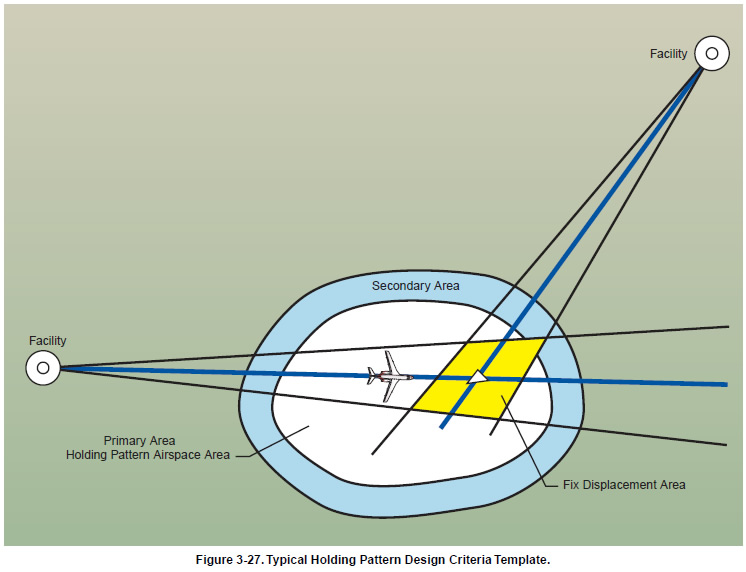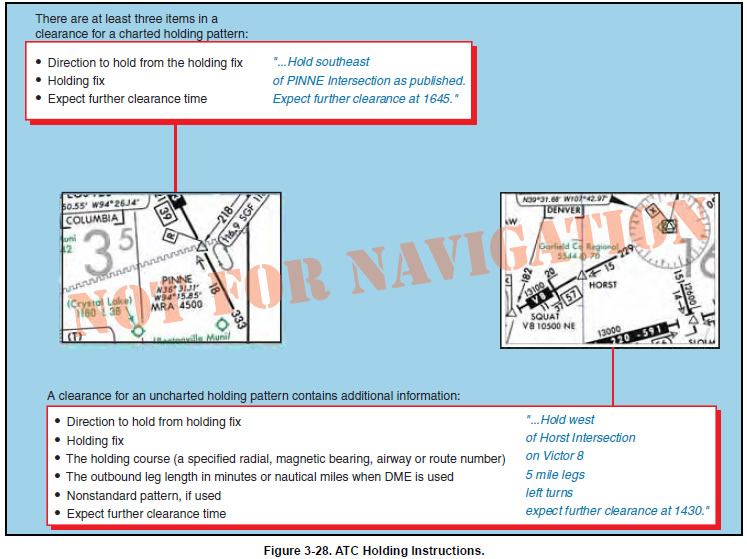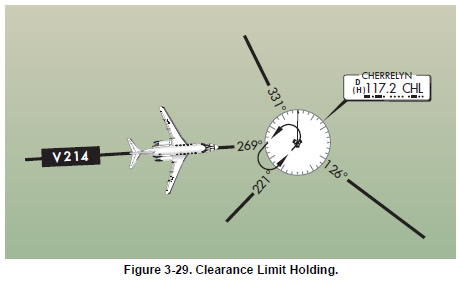|
HOLDING PROCEDURES
The criteria for holding pattern airspace is developed
both to provide separation of aircraft, as well as obstacle
clearance The alignment of holding patterns typically
coincides with the flight course you fly after leaving the
holding fix. For level holding, a minimum of 1,000 feet
obstacle clearance is provided throughout the primary
area. In the secondary area 500 feet of obstacle clearance
is provided at the inner edge, tapering to zero feet at the
outer edge. Allowance for precipitous terrain is considered,
and the altitudes selected for obstacle clearance
may be rounded to the nearest 100 feet. When criteria for
a climb in hold are applied, no obstacle penetrates the
holding surface. [Figure 3-27]
There are many factors that affect aircraft during holding
maneuvers, including navigational aid ground and
airborne tolerance, effect of wind, flight procedures,
application of air traffic control, outbound leg length,
maximum holding airspeeds, fix to NAVAID distance,
DME slant range effect, holding airspace size, and
altitude holding levels. In order to allow for these factors
when establishing holding patterns, procedure
specialists must apply complex criteria contained in
Order 7130.3, Holding Pattern Criteria.

ATC HOLDING INSTRUCTIONS
When controllers anticipate a delay at a clearance limit
or fix, pilots will usually be issued a holding clearance
at least five minutes before the ETA at the clearance
limit or fix. If the holding pattern assigned by ATC is
depicted on the appropriate aeronautical chart, pilots
are expected to hold as published. In this situation, the
controller will issue a holding clearance which includes
the name of the fix, directs you to hold as published, and includes an expect further clearance (EFC) time.
An example of such a clearance is: “Marathon five
sixty four, hold east of MIKEY Intersection as published,
expect further clearance at 1521.” When ATC
issues a clearance requiring you to hold at a fix where a
holding pattern is not charted, you will be issued complete
holding instructions. This information includes
the direction from the fix, name of the fix, course, leg
length, if appropriate, direction of turns (if left turns
are required), and the EFC time. You are required to
maintain your last assigned altitude unless a new altitude
is specifically included in the holding clearance,
and you should fly right turns unless left turns are
assigned. Note that all holding instructions should
include an EFC time. If you lose two-way radio communication,
the EFC allows you to depart the holding
fix at a definite time. Plan the last lap of your holding
pattern to leave the fix as close as possible to the exact
time. [Figure 3-28]

If you are approaching your clearance limit and have
not received holding instructions from ATC, you are
expected to follow certain procedures. First, call ATC
and request further clearance before you reach the fix.
If you cannot obtain further clearance, you are expected
to hold at the fix in compliance with the published
holding pattern. If a holding pattern is not charted at
the fix, you are expected to hold on the inbound course
using right turns. This procedure ensures that ATC will
provide adequate separation. [Figure 3-29] Assume you
are eastbound on V214 and the Cherrelyn VORTAC is
your clearance limit. If you have not been able to obtain
further clearance and have not received holding instructions,
you should plan to hold southwest on the 221
degrees radial using left-hand turns, as depicted. If this
holding pattern was not charted, you would hold west
of the VOR on V214 using right-hand turns.
Where required for aircraft separation, ATC may
request that you hold at any designated reporting point
in a standard holding pattern at the MEA or the MRA,
whichever altitude is the higher at locations where a
minimum holding altitude has not been established.
Unplanned holding at en route fixes may be expected
on airway or route radials, bearings, or courses. If the
fix is a facility, unplanned holding could be on any
radial or bearing. There may be holding limitations
required if standard holding cannot be accomplished at
the MEA or MRA.

|



